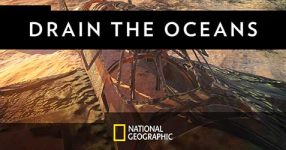The documentary “Drain the Oceans: Lost Nukes of the Cold War” delves into the hidden and terrifying reality of lethal nuclear weapons abandoned beneath our oceans during the Cold War. The fear that these destructive weapons still lie submerged, concealed in the depths, fuels the narrative.
Uncovering Cold War Secrets:
The narrative unfolds with the backdrop of the Cuban Missile Crisis in October 1962, a pivotal moment in Cold War history. The tension between the United States and the Soviet Union brings the world to the brink of nuclear apocalypse. The documentary explores hidden flashpoints and unveils the secrets of top-secret experiments off the waters of Northern California.
Discovering USS Independence:
Maritime archaeologist Dr. James Delgado leads a team in exploring a mysterious wreck discovered off the coast of San Francisco. Using advanced technology, they unveil the submerged wreckage of the USS Independence, a World War II aircraft carrier. The exploration raises questions about its unmarked location, damage, and its unexpected link to Cold War nuclear testing in Bikini Atoll.
Bikini Atoll Nuclear Testing:
The narrative takes a historical turn to July 1946 at Bikini Atoll, where obsolete warships, including the USS Independence, become victims of atomic testing. The destructive force of the atomic bomb leaves its mark on the carrier, leading to its eventual relocation to the depths off Northern California. The film sheds light on the consequences of nuclear weapons testing and the subsequent fate of the USS Independence.
Cold War Nuclear Dangers:
The documentary shifts to the height of the Cold War, detailing Operation Chrome Dome, where B-52 bombers patrol European skies armed with hydrogen bombs. A harrowing incident in 1966 involving a lost nuclear bomb off the coast of Spain adds to the suspense. The search for the bomb beneath the Mediterranean Sea illustrates the challenges of recovering lost nuclear weapons.
Tragedy of USS Thresher:
The focus then turns to the tragic loss of the USS Thresher, a nuclear-powered submarine, during sea trials in 1963. Deep-sea explorer Dr. Bob Ballard investigates the wreckage, revealing the catastrophic consequences of reaching crush depth. The analysis of the Thresher’s demise raises questions about the complexities and dangers of Cold War submarine operations.
Soviet Submarine K-129:
The documentary transitions to the Soviet side, exploring the mission of the K-129 submarine, armed with advanced nuclear missiles. The narrative unfolds a tale of espionage, revealing a covert operation to locate and recover the wreckage of the lost Soviet sub. Investigative journalist Josh Dean uncovers Cold War secrets, including the mysterious circumstances surrounding the slicing of K-129’s nose.
The Glomar Explorer and “The Claw”:
The documentary introduces the secretive Glomar Explorer, owned by eccentric billionaire Howard Hughes, and its mission to recover K-129 using a device called “The Claw.” Archival footage reveals the astonishing attempt to lift a portion of the submarine from the ocean floor. The revelation prompts questions about the extent of lost Soviet warheads and the classified missions conducted during the Cold War.
Legacy of the Cold War:
“Drain the Oceans: Lost Nukes of the Cold War” concludes by acknowledging the scars left by the Cold War beneath the oceans. With the collapse of the Soviet regime, the documentary reflects on the unrecovered nuclear weapons and radioactive waste that continue to pose threats to the marine environment. The Cold War’s impact on the underwater world serves as a haunting reminder of the dangers and secrets that still lie beneath the surface.












